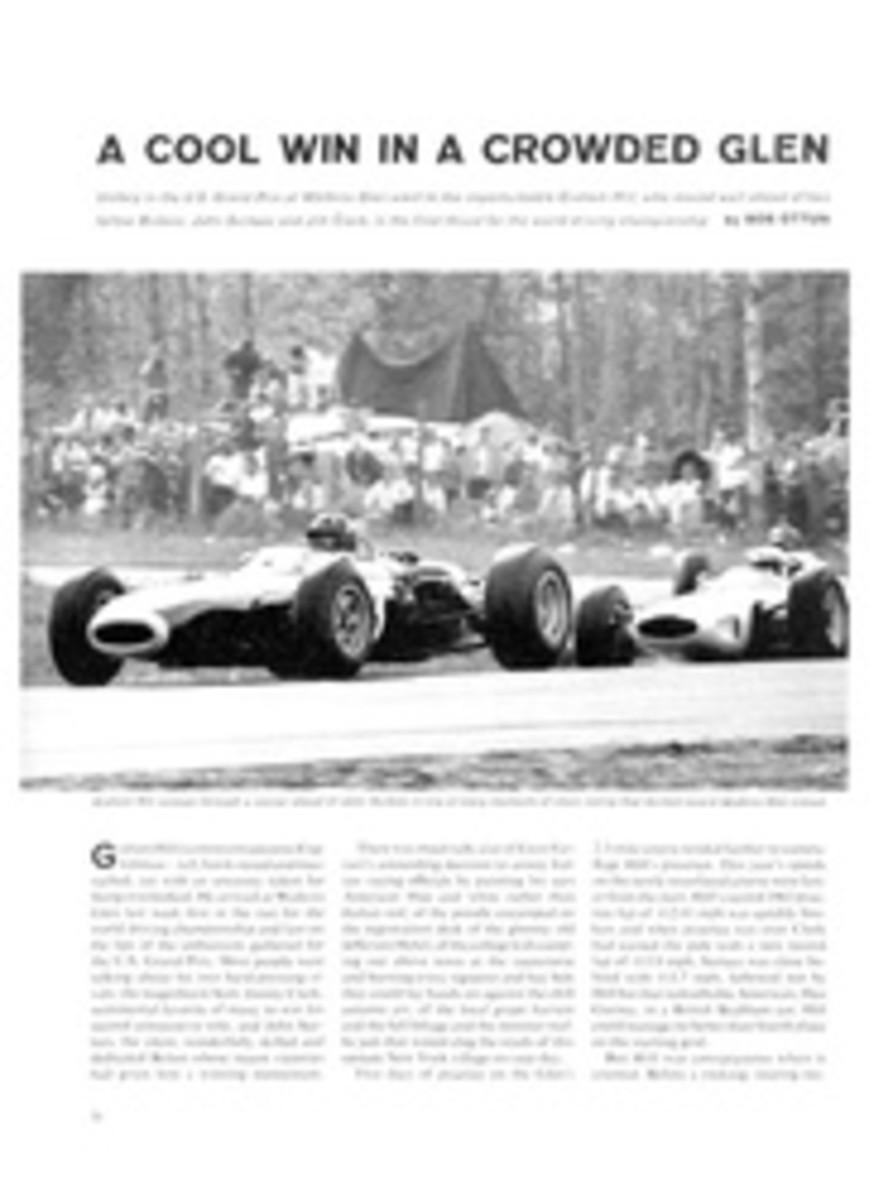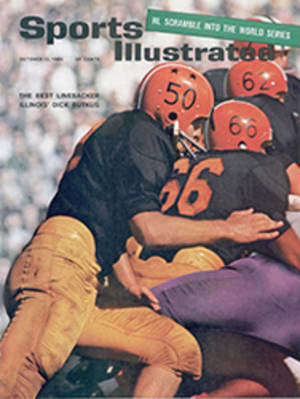
Two old shoestringers jolt the jet set
As the shadows grew menacingly long over the Bonneville Salt Flats last Friday afternoon, everyone did his sympathetic best not to notice. In the timers' shack half a dozen white-clad United States Automobile Club officials sat silent and bored, their wooden chairs tipped back.
It had been this way for six days. Wingfoot Express, a home-designed hot rod, had swept back and forth over the flats 14 times, reaching a top speed of 313 mph. That would be fine for the family Chevy, but on the Utah salt, when the world land-speed record is the goal, no one takes a man—or a car—seriously at much less than 400.
Wingfoot Express balked stubbornly until nearly everyone had written it off. Then, two hours before sunset of the last day reserved for it on the salt this year, the jet woke up the timers. Like an underslung missile mounted on wheels, it roared south to north, entered the measured mile and left it seconds later. The speed was an encouraging 406.5 mph. Minutes later it came the other way at 420.07, the fastest mile ever recorded on land. The average speed of 413.2 broke the record of 407.6, established last year by Craig Breedlove.
"I never thought Walt'd do it," whispered a local mechanic. "Maybe his brother. Art, but not Walt."
Well, who did?
Walt is Walter Arfons of Akron, who built the car with the help of Tom Green of Wheaton, Ill., the driver. A 47-year-old onetime feed-mill operator, Walt Arfons and his brother began tinkering with jet cars and drag racers 10 years ago, each of them eventually using a separate part of the old mill as his garage, and each of them going his own hot-rodding way. The know-somethings said Art had a hot car this year, but that poor Walt—no longer able to drive because of a heart attack—did not. Walt's Wingfoot, they said, was a slue-foot.
But Wingfoot, a pure jet powered by a 10,000-horsepower J-46 Westinghouse triple jet engine, went faster on land than any car or motorcycle before it. Having said that, it is best to stop talking, for beyond that statement lies controversy. Breedlove, for example, was denied recognition abroad because his Spirit of America had only three wheels and hence was not an automobile. Donald Campbell and his British backers scorned Breedlove and can be depended upon to scorn Green and Arfons because Wingfoot's engine does not deliver power to the wheels.
Yet these technicalities bother only a few. It takes big money to mount a land-speed record attempt, but big publicity emerges. Thus the tire, gasoline and parts manufacturers who pick up most of the tab are willing to back a pure jet, a turbojet, a motorcycle or a ricksha if it will go more than 400 mph. Goodyear has a heavy investment in Wingfoot Express—as does Firestone in Art's Green Monster—and it was a Goodyear executive who said: "You didn't see the razor-blade folks give Roger Maris the cold shoulder because of the asterisk."
Automobile or not, Wingfoot is a four-wheeled vehicle. It is 24 feet long, 42 inches high, weighs 4,800 pounds and its history is hardly the stuff on which grandiose speed records are built.
Driver Tom Green is an engineer for P.A. Sturdivant Co. in Elmhurst, Ill. He met Arfons in 1962 when both were attending an auto show in Chicago. "We talked about cars for a few minutes," remembers Green, "and we seemed to realize that each of us had what the other lacked. I didn't know one end of a jet engine from the other. Walt said he knew little about my specialty, aerodynamics."
As soon as Walt Arfons got back to Akron, work began on Wingfoot. Green had a full-time job he wanted to keep, but Arfons was now making his living building, selling and racing cars. His avocation was his vocation.
The two "built" Wingfoot via correspondence. Arfons worked on the steel frame and the engine at his garage in Akron. "There isn't a part in that crate that isn't handmade—axles, ducts, everything," says Arfons. By mail, Green was exacting in his requests: the rear wheels must be farther apart than the front ones; the weight must be toward the rear; above all, keep it low, low, low. Green had decided that the trouble with Donald Campbell's $4 million Bluebird was its huge wheels. "I knew enough aerodynamics to know you want a small car for land-speed record runs," he says. "We had an arrow in mind," says Arfons. "Weight and fin feathers in the rear, tapering almost to a point in front."
Green built the body of steel and aluminum and "a bit of a Volkswagen fender." When he trucked it to Akron, it did not fit the frame Arfons had completed. But this was no problem for Arfons, his welding torch, hammer and wrenches. Soon everything fitted, and in the spring of 1963 the Arfons-Green dream car, really a glorified hot rod with a jet engine, was ready to roll.
Wingfoot's first roll was a near disaster. When it was tested near Detroit, it went faster than the builders had expected, swerved off course, across U.S. Highway 75, through a fence and into the woods. The test driver was uninjured but the wreck literally produced Arfons' heart attack. Green, with no race-driving experience, agreed to pilot the jet after that.
That summer Wingfoot was taken to the Salt Flats, where trouble of a different sort plagued it. The huge engine ingested salt. The faster it went, the more salt it swallowed. Its top speed was 315 mph, but Goodyear was game to try again in 1964.
When the elongated blue speedster was unloaded on the flats a week ago Sunday, it still did not impress anyone. Walt Arfons had been on the salt too many times before, and he had acquired an image as one of the shoestring boys who clutter up the place between runs by such better-heeled types as Campbell, Breedlove and Mickey Thompson. Since his brother, Art, had also dealt in Salt Flats frustration, the name Arfons was doubly discounted.
After trial runs Sunday, Arfons and Green pronounced the car ready. On Monday, it ran well but slowly. "The motor didn't have it," said Green. "We'll put a new one in," promised Walt.
Ho hum.
On Tuesday there was no new motor, and in trial runs Wingfoot never got near 300. It was the same Wednesday.
By Thursday the new motor was installed, but crosswinds swept the flats. All day the timers waited. And waited. Nobody did anything at all, except that Green wiped the dust and salt off Wingfoot's blue body now and again, and Arfons picked up a wrench and moved in on it, only to back away sheepishly, as if everyone knew he really had no bolts in need of tightening.
Friday—the last available day—was still windy and Wingfoot was still balky. "Fuel-pump troubles," groused Arfons. Morning passed. Green and Arfons saw their hopes riding away with the fast-falling sun. Finally Arfons tried a vital 1/16th of a turn on the idle adjustment. Then he said O.K. and reminded Green to be sure to use the afterburner.
Clad in a pale-blue Goodyear-marked uniform and a safety helmet, Tom Green wiggled his 5 feet 11 inches into the cockpit and roared down the course.
It was 4:06 p.m. Green, steering with one hand, pumped a lever with the other, and the afterburner fired. "It went zoom, zoom, zoom. That's the only way I can describe it. The air speed indicator told me I was going 440, but I didn't use the afterburner enough in the measured mile. After I popped the chutes, they told me my official speed was only 406."
Green sensed that something had happened to the motor and told Arfons, who found that somewhere along the 10-mile straightaway Wingfoot's engine had ingested something—most likely a bolt—and four blades had been damaged. "What had happened further in the motor we could only guess," said Arfons. It was now 4:45, and there was no time to look, because a driver is required to make his return run within an hour, or not at all. There was no hesitation. Wingfoot roared into the measured mile again. This trip Green fired the afterburner three times. The spurts were enough, and the record fell.
"You know," Green exulted moments later, "the car handles better at 400 than 200. It has the power for 500. Now I wonder what the limit of speed on land may be. I don't think 700 is out of reason."
Walt Arfons listened intently as Green described the noisy life inside Wingfoot at 400-plus. "It rattles a lot," he said. "And those little irregularities in the salt—you feel every one. You sort of get the feeling you are inside a rocket that's rattling around on the ground."
"It's a great moment," said Walter Arfons—and a moment was all it was. For on Monday afternoon brother Art turned loose his 17,000-horsepower Monster, the most powerful car ever built. Art, 38, had only planned a test run, but the weather was right and the engine—a type used by the B-58 Hustler bomber—was ready. His first sweep through the mile was a mere 396.3, but he was back minutes later in an eerie 479 for an average of 434.02—a new record, by far. Nor was there any telling how high he might push the record during the week as he risked more runs. "It howls like an animal," Art had said of his car, and its howl was one of success.
Walt Arfons was not there to see Art's triumph. "Have to be getting along," he had said as he packed up the day before. What he had not said was that brothers Walter and Arthur Arfons of Akron, who stopped speaking to each other during the years of racing failure and frustration, have no plans to speak to each other during the years of prizes and profits.
PHOTO
HAPPY TEAM: WALT ARFONS AND GREEN
PHOTO

